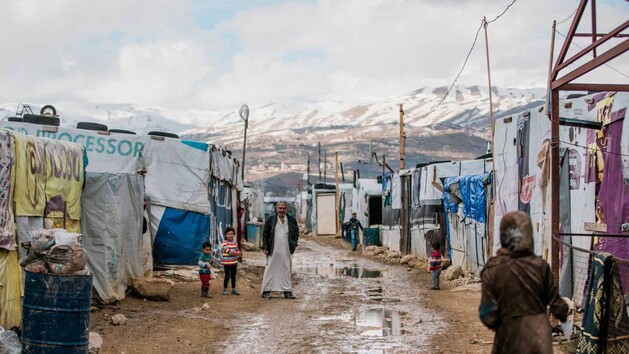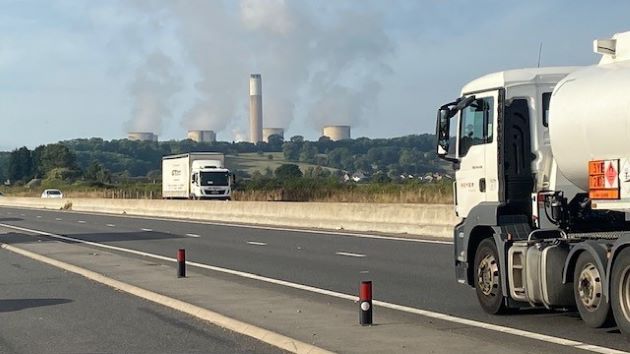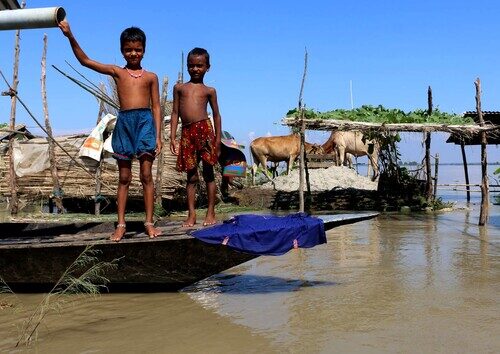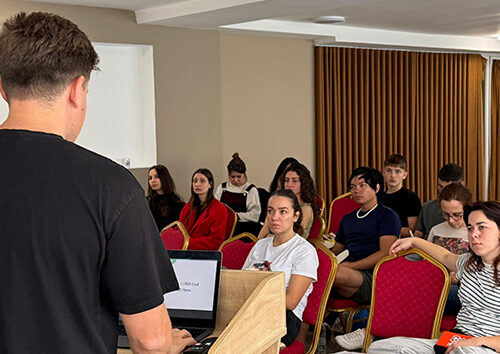13 June 2024|St. Albans, UK [David Wright]
Imagine you live near the coast and sea levels are rising, or near a volcano that is starting to erupt, or your crops and livestock are dying because it hasn’t rained for years, or it’s so hot that the forests are on fire, or an earthquake or landslide has just destroyed your home and there’s a tsunami on its way, or it’s rained so much that the whole neighbourhood is under water. You are clearly going to move somewhere else – with your loved ones and as much as you can carry – to somewhere safer – no matter how far or how long it takes.
In 2001, British environmentalist, Norman Myers, explained how environmental refugees would become ‘the growing global phenomenon of the 21st century’. He described the growing number of people on our planet who ‘can no longer gain a secure livelihood in their homelands because of drought, soil erosion, desertification, deforestation, famine and other environmental problems, together with the associated problems of population pressures and profound poverty. In their desperation, these people feel they have no alternative but to seek sanctuary elsewhere, however hazardous the attempt’. (1)
While some would become displaced internally, most would abandon their homelands with little hope of returning. By 1995 the number of such environmental refugees began to overtake traditional refugees, i.e., those escaping political oppression, religious persecution, or ethnic troubles. Myers predicted that environmental refugee numbers would not only increase as more and more impoverished people pressurised their overloaded ecosystems but would then explode when the impact of global warming took hold, with its rising sea levels, coastal flooding, disruptions to rainfall systems, and increasing droughts of ‘unparalleled severity and duration’.

Traditional, environmental and climate refugees.
The United Nations (UN) defines traditional refugees as those who cross international borders to escape war, violence, or conflict, describing ‘environmental refugees’ as those who flee natural disasters, and ‘climate refugees’ as those who leave their homes because of global warming and climate change.
Thirty years ago, the United Nations Commission for Refugees (UNHCR) Sadako Ogata warned that ‘the relationship between refugees and the environment had been long overlooked’. Ten years later, the UNHCR Refugee Agency admitted that ‘not much had changed … except there were twice as many refugees … and the level of environmental destruction has accelerated’ (2).

Now, another ten years on, and the catastrophic effects of natural disasters such as earthquakes, associated tsunamis, flooding, landslides, wildfires, droughts, and volcanic eruptions, together with the irrefutable impact of climate change, are forcing even more people to abandon their homes and livelihoods to become ‘environmental refugees’. When the ecological consequences of accelerating internal conflict and wars are also included, it explains why the International Red Cross recently reported that we now have more environmental refugees than political ones. (3)
Climate change acts as a threat multiplier impacting on access to water, food security, and livelihood which in turn aggravates geopolitical conflicts and creates even more displacement surges. Desertification, rising sea levels, overwhelmed sanitation systems, and polluted or scarce water simply force more people to migrate, forcing the international community to deal with the subsequent and immense environmental pressure on the places they move to, including most refugee camps (4)
In 2022, 108 million people worldwide had been forcibly displaced due to ‘persecution, conflict, violence, human rights violations and events that seriously disturb public order’, and by the end of 2024 the UN Refugee Agency expects a further 22 million people to be forcibly displaced or stateless. The International Institute for Economics and Peace however is now echoing Norman Myers predictions by forecasting over 1.2 billion displaced people globally by 2050 – due purely to climate change and natural disasters, with 2.8 billion people still residing in countries facing severe ecological threats. (5)

While no corner of our planet seems untouched by issues relating to displacement and migration, most of the countries being hit first, and worst, are those that emit the least carbon emissions (6), which means around 60% of all refugees and internally displaced people now live in areas that are the most vulnerable to climate change. (7)
Environmental and climate refugees however are not yet legally protected by the 1951 Refugee Convention, unless the risk of war, violence or persecution can be shown to have been increased by environmental causes. For example, people recently fleeing Cameroon into neighbouring Chad to escape hostilities between farmers and fishermen triggered by declining water supplies linked to temperature change. (8)
Although the Bible does not use the term ‘refugee’, it has plenty to say about people called strangers, sojourners, exiles, aliens, and foreigners. The Biblical history of Israel is essentially a story about immigration and refugees, with many of its leading characters forced to emigrate due to famine. People like Abraham and Sarah, Isaac and Rebekah, Jacob and his family, Naomi would all be classified today as environmental refugees. Scripture repeatedly reminds us that the Israelites’ experiences in Egypt, and elsewhere, should serve as motivation for us on how to treat those found in similar circumstances today. ‘The foreigner residing must be treated as your native-born, love them as yourself for you were foreigners in Egypt’. (9)
______________________________________________________________________________
References
- ‘Environmental refugees: a growing phenomenon of the 21st century’, by Norman Myers, in the Philosophical Transactions of the Royal Society of London, 29/4/,02.
- ‘A critical time for refugees and their environment (again)’ by Andrew Harper, in UNHCR Innovation, 10/12/06.
- ‘Climate change and human mobility: A humanitarian point of view,’ by the International Federation of Red Cross and Red Crescent Societies, 2009.
- As for 2.
- ‘Ecological Threat Report 2023’, by the Institute for Economics and Peace.
- ‘Evidence to action – climate change and the global south’, by Yevanit Reschechtko, 2020.
- ‘Climate change and displacement: the myths and facts’, by Kristy Siegfried on the UNHCR UK Website, 15/11/23.
- As for 7.
- Leviticus 19:34, NIV.
[Photos: ADRA International, Shutterstock and David Neal] Featured image: Shuterstock, Bogra district, Bangladesh floods, 2021.
David L. Wright’s passion and concern for the natural world existed long before environmental matters gained popular interest. Hundreds of UK children, teens and youth in schools, after-school clubs, and Pathfinder leaders benefitted from his understanding of geography and natural biology. Now retired, he lives in Devon, UK.



